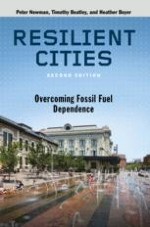2017 | OriginalPaper | Chapter
5. Build Biophilic Urbanism in the City and Its Bioregion
Authors : Peter Newman, Timothy Beatley, Heather Boyer
Published in: Resilient Cities
Publisher: Island Press/Center for Resource Economics
Activate our intelligent search to find suitable subject content or patents.
Select sections of text to find matching patents with Artificial Intelligence. powered by
Select sections of text to find additional relevant content using AI-assisted search. powered by
